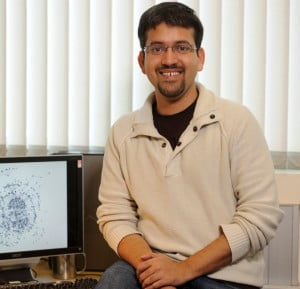
In order to advance understanding of protein structures and their interactions for a wide range of applications, it is important that researchers have a really clear idea of the bonds between the molecules of which they are composed.
Biomolecules are often depicted in a way that primarily highlights covalent bonds (e.g. in the often-used ball and stick model). However, in natural molecules non-covalent bonds are very common, and these need to be visualised effectively in order to help researchers gain a fuller understanding of the features of a particular protein.
In order to help achieve this, the group of Lister Institute Fellow Dr. M. Madan Babu has been leading the development of an innovative and extensive atlas of non-covalent bonds in proteins, called the Protein Contacts Atlas.
This project was conceived by Dr. A.J. Venkatakrishnan and Dr. Babu, and was executed jointly with Dr. Melis Kayikci. The prototype of the webserver was made by Mr. James Scott-Brown, a former summer student in Madan’s group. Dr. Charles Ravarani and Dr. Tilman Flock also helped with the webserver.
The Protein Contacts Atlas features visual representations of over 100,000 biomolecules from the Protein Data Bank (PDB). Individual proteins can be analysed and the interactions within or between chains displayed. In addition, the Atlas also shows sequences, secondary structures and residues, and their associated contacts, for a comprehensive understanding of any protein.
Here’s an example visualisation of the protein molecule 1QNE – note that the different chains that make up the structure can be highlighted individually:

This work is discussed in a recent paper published on the Nature Structural & Molecular Biology website entitled “Visualization and analysis of non-covalent contacts using the Protein Contacts Atlas.”
It is hoped that the visualisations and structure reports that can be created will be of great use to researchers in a wide range of application areas, helping to understand the different levels of organisation present in organic structures.
Dr. Babu leads the Regulatory Genomics and Systems Biology group at the MRC Laboratory of Molecular Biology, Cambridge, UK. He also edits a number of prestigious academic journals and was awarded a Lister Research Prize in 2014 to help fund his research. As he explains;
“The Lister Prize gave me the opportunity to discuss our work with scientists from different research areas during the development phase of the Protein Contacts Atlas. This was important as it inspired us to design and come up with new ways of representing biomolecules that would help researchers address their questions.”
“I would like to thank the Lister Institute for their generous support and the amazing scientific network of past and current Fellows with very different expertise.”
“I hope that the Protein Contacts Atlas will enable scientists from diverse disciplines to gain insights through new and novel ways of representing biomolecules that were not possible before.”
At the Lister Institute we aim to support the biomedical field in the UK and Republic of Ireland through our prestigious research prizes that also provide access to an extensive network of experienced academics.
We are very pleased to support Dr. Babu’s work and look forward to viewing the impact that the Protein Contacts Atlas can achieve in the field.



